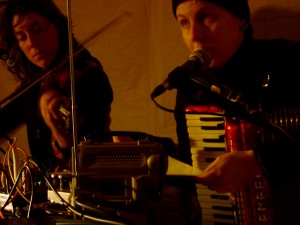
A multi-media performance made together with Annabelle Chvostek using micro-radio transmission, live electronic and acoustic instruments, and video projection. (2004)
Conceived and created for the HTMlles: Circulation .01 2004, produced by Studio XX, Montréal. Touring generously supported by funds from the Canada Council for the Arts, Media Art and Audio Art Section.
Premiered at Digitales, in Brussels, Belgium (January 2004), with subsequent performances at Wohlfarht, Rotterdam; Rote Flora, Hamburg; Bootlab/Club Transmediale, Berlin; live on ORF Kunstradio radio, Vienna; A4, Bratislava; Rad’a Gallery, Montréal; Send+Receive Festival, Winnipeg; The Western Front, Vancouver.
The Automated Prayer Machine was conceived in response to the growing sense of foreboding and despair over world events, and as an antidote to the escalation in media hysteria and increasingly sensationalistic news reporting that encourages apathy and fear rather than any kind of productive or positive action. The winter of 2003-2004 seemed particularly dark in this respect, as the U.S.-led invasion of Iraq dominated the news, while enormous international rallies for peace received relatively little attention and did nothing to stall the actions of the Bush administration. Inspired in part by the transmission properties of a prayer wheel, where wind, water, human, or even electronically powered wheels are believed to activate a written prayer or mantra, Chvostek and I proposed a shift from apathy to empathy and from indifference to compassion by recasting radio receivers from squawkboxes to agents of reverie. We sought to rethink radio as capable of manifesting a common space for unfolding human hopes and aspirations.

The composition of the piece relied on radiophonic sources such as live sampled radio, pre-composed samples of syndicated American talk radio, and prayers that we asked friends and acquaintances to record on my telephone voicemail box. We deliberately left our definition of prayer wide open to interpretation by the people who donated prayers for us to use, so we received prayers from monotheists, polytheists, agnostics and atheists. For ourselves, we conceived of prayer as the articulation of desires, wishes or aspirations, with or without a religious context.
In performance, we enhanced the radiophonic character of the piece by employing a low-watt FM transmitter to narrowcast the sound to multiple radio receivers spread throughout the audience, as well as using the stereo PA in any given venue. Our circuit of transmission remained small:with the radios spread out among the audience (on or under chairs, in people’s laps, or on ledges), and range of broadcast occurring almost entirely within our line of sight inside the venue. Additionally, we created sound through feedback circuits within the circuit, both between the microphones and the speakers, and by sampling our signal from a radio receiver back into the narrowcast, which was then resampled and retransmitted. Digital video projection, acoustic instruments such as accordion and violin, and electronics (samplers, live effects processing) completed a circuit of analogue and digital, wired and wireless practice.
As we continued to develop the Automated Prayer Machine while on tour, we began to think more deeply about the relationship between FM radio and prayer as forms of wireless transmission. Both express something of the very mortal desire for profound communication across distance and time, while also representing the failure to realize total knowledge of or union with the Other. We used prayers in many languages, particularly as we continued collecting prayers after each show while on tour across Europe, so many of the prayers were incomprehensible to some audience members. The emotional quality and even fragility of the prayers was echoed by the fragility of the radio transmission: prone to interference and strange bursts of static as we played in big cities where the radio dial was already completely full of licensed stations. What was left, then, of these prayers? Their power seemed located in the accumulation of many small, incidental messages of hope and good will, directed at anyone and no one at the same time; always partial, affective, but never complete, each side of the transmission unknown to one another. Faith, in other words, that it was worth speaking aloud and listening at all.
Photo credit: Alexis O’Hara
![]()